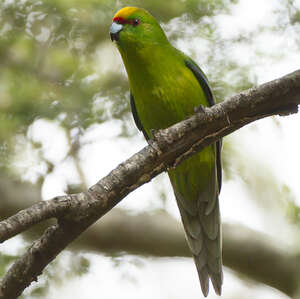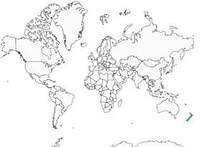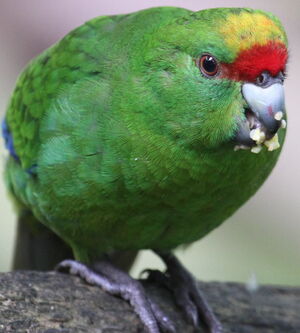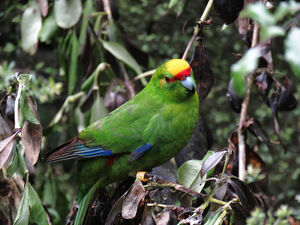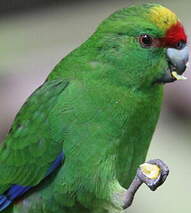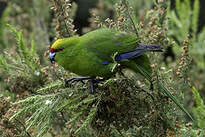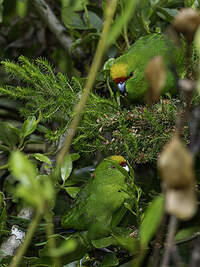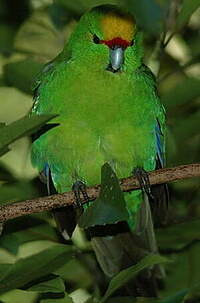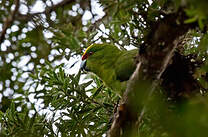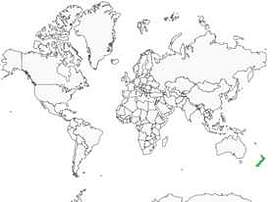Yellow-crowned Parakeet
Cyanoramphus auriceps - Perruche à tête d'or
Identification
From afar, the Yellow-crowned Parakeet looks like an entirely green parakeet, brighter and shinier on top than underneath. When perched, the blue of the flight feathers and of the upper coverts is visible, as well as a golden yellow blotch on the forehead above a red band going from the beak to both eyes. It can be mistaken for the Sparrman's Parakeet (Cyanoramphus novaezelandiae) which lives in the same environment. With the latter, the yellow is replaced by red, which, above the beak, does not reach the eyes.
Subspecific information monotypic species
Foreign names
- Perruche à tête d'or,
- Perico maorí cabecigualdo,
- periquito-de-coroa-amarela,
- Springsittich,
- ugráló papagáj,
- Geelvoorhoofdkakariki,
- Parrocchetto frontegialla,
- gulpannad parakit,
- Gulkroneparakitt,
- kakariki skákavý,
- kakariki žlutočelý,
- Springparakit,
- kruunuviherkaija,
- cotorra frontgroga,
- modrolotka żółtoczapkowa,
- Желтолобый прыгающий попугай,
- キガシラアオハシインコ,
- 黄额鹦鹉,
- gulpannad parakit,
- 黃額鸚鵡,
Habitat
Behaviour character trait
The Yellow-crowned Parakeet is usually encountered in small groups of a few individuals, often in pairs. It descends to the ground much less often than the Sparrman's Parakeet, seeking its food in the canopy. However, in small islands devoid of their land predators, it frequently comes to the ground.
Reproduction nesting
This species of birds nests in hollow trees. Eggs are laid from October to December, but additional clutches may occur throughout the year, if the birds have access to an abundant food source. The female lays between 5 and 9 eggs, incubated for around three weeks. The chicks, tended to by the female (while the male provides the food) stay in the nest for nearly six weeks. This species is the Yellow-crowned Parakeet.
Geographic range
Threats - protection
IUCN conservation status
concern
in the Wild
threatened
evaluated
The Yellow-crowned Parakeet is classified as Near Threatened by the IUCN and BirdLife International. On the Chatham Islands, the population of the forbesi subspecies has dropped below one hundred birds. In this archipelago, it has suffered from habitat modification, but also from hybridization with the Karrman Parakeet.
On the other hand, as with many endemic species of New Zealand, its populations have been severely reduced by the action of mammalian predators introduced by European colonists, such as cats, stoats, and rats.
Sources of information
- IOC World Bird List (v15.1), Gill, F and D Donsker (Eds). 2025-12-07.
- The hand guide to the birds of New Zealand, Robertson Hugh et Heather Barrie
- Vol. 4 - Handbook of the Birds of the World, Josep del Hoyo-Andrew Elliott-Jordi Sargatal
- Parrots, Tony Juniper
Other sources of interest
 Specification sheet created on
31/07/2023 by Georges Olioso
Specification sheet created on
31/07/2023 by Georges OliosoTranslation by AI Oiseaux.net
© 1996-2026 Oiseaux.net
- Accipitriformes
- Aegotheliformes
- Anseriformes
- Apodiformes
- Apterygiformes
- Bucerotiformes
- Caprimulgiformes
- Cariamiformes
- Casuariiformes
- Charadriiformes
- Ciconiiformes
- Coliiformes
- Columbiformes
- Coraciiformes
- Cuculiformes
- Eurypygiformes
- Falconiformes
- Galliformes
- Gaviiformes
- Gruiformes
- Leptosomiformes
- Mesitornithiformes
- Musophagiformes
- Nyctibiiformes
- Opisthocomiformes
- Otidiformes
- Passeriformes
- Pelecaniformes
- Phaethontiformes
- Phoenicopteriformes
- Piciformes
- Podargiformes
- Podicipediformes
- Procellariiformes
- Psittaciformes
- Pterocliformes
- Rheiformes
- Sphenisciformes
- Steatornithiformes
- Strigiformes
- Struthioniformes
- Suliformes
- Tinamiformes
- Trogoniformes

